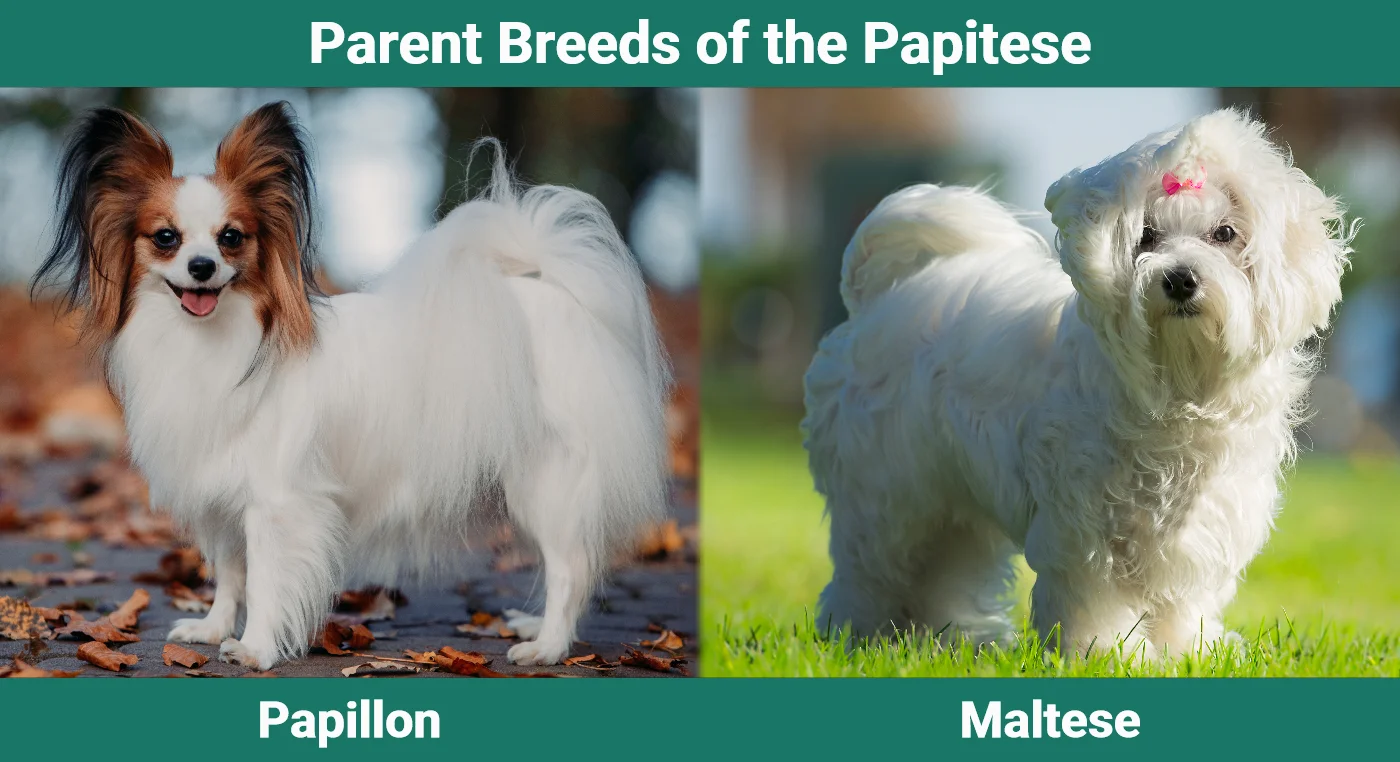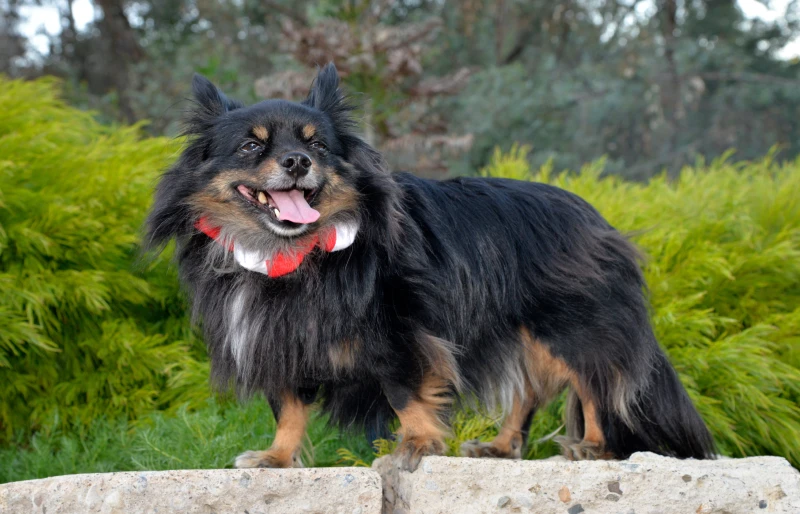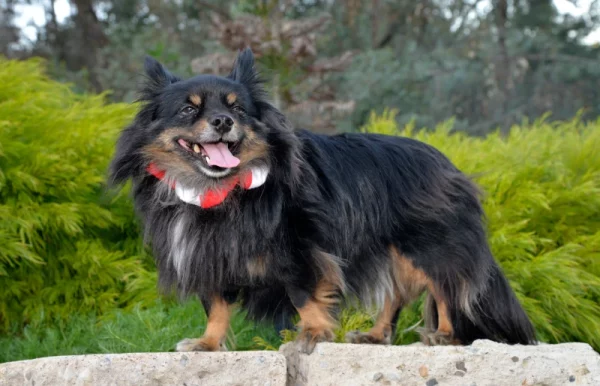Click Below to Skip Ahead
The Papitese is a mixed dog breed that combines the Papillon with the Maltese. Owning a mixed breed can be a great option if you can’t choose between two breeds—you get a bit of both in one dog!
If you’re interested in learning more about this toy breed, read on as we delve into the temperament and qualities that you can expect from the Papitese.
Breed Overview
Height:
8–10 inches
Weight:
5–10 pounds
Lifespan:
12–16 years
Colors:
White, black, brown, silver, fawn
Suitable for:
Families, single people, seniors, living in apartments or houses
Temperament:
Playful, friendly, gentle, affectionate, devoted
To better understand the Papitese, you should get to know the Papillon and Maltese. Some of their offspring will take after one parent more than the other, in either temperament or appearance, but they will all be toy dog sized because both parents are so small.
The Papitese has silky and long fur that comes in various colors, but these dogs are typically white with black and/or brown patches. They will probably have large ears, but not necessarily the famous butterfly ears of the Papillon.
Papitese Puppies
Papitese puppies will be challenging to find; even as a mixed breed, they aren’t as common as some others. But if you find a Papitese breeder, ensure that they are a high-quality one. You should visit the breeder and their dogs in person, and ask plenty of questions, as this can give you a better idea of the kind of person the breeder is.
You can try looking for one of these puppies through social media and speaking to Papillon and Maltese breeders. You can also think about adopting a Papitese, but finding such a specific mixed breed at your local animal rescue will be difficult. That said, adoption is definitely a worthwhile cause!

Temperament & Intelligence of the Papitese
Papitese can be gentle and sensitive, but they also have a great deal of energy and are smart. They are quite prone to separation anxiety, so someone should be home much of the time if you’re considering one of these dogs. They thrive on companionship, love being doted on, and are fairly social and friendly.
They make good watchdogs, and like many small dogs, they will announce the presence of any suspicious activity by barking. But they don’t make good guard dogs for obvious reasons.
Are These Dogs Good for Families?
The Papitese is great with children, but they are recommended for older kids. Young children might accidentally hurt these tiny dogs. This is why teaching kids how to behave around dogs and treat them with respect is essential.
That said, the Papitese do make wonderful companions for children because of their gentleness and playfulness.
Does This Breed Get Along With Other Pets?
The Papitese is known to get along quite well with other pets. But socializing them is essential for this to work. If they are raised with other animals in the home, they will get along quite well.
But if you have any large, rambunctious dogs, there’s a chance for the Papitese to be accidentally hurt during rowdy play.
Things to Know When Owning a Papitese
Food & Diet Requirements
The Papitese will require high-quality dog food made for small and high-energy dogs. It should also be geared for your dog’s current age and weight. It’s essential to give small kibble to small dogs so they can eat it easily, and they need the appropriate nutritional balance to support their systems.
Check the feeding guidelines on your dog’s food bag, and you can also speak to your vet about what kind and how much food your Papitese should have. They also need constant access to fresh, clean water every day.
Exercise
The Papitese is a high-energy dog that will need their exercise needs met every day. But this is typically easy to accomplish, given their size. They only need about 30 minutes of exercise daily through walks and playtime. If the weather is awful, you can have playtime inside, which should also help with daily exercise.
Training
These dogs are intelligent and eager to please, so they are easily trained. They are sensitive dogs, though, and should only be trained using positive reinforcement and without any form of punishment.
The Papitese can also be prone to small dog syndrome, which should not be encouraged, and good training will help prevent it. The Papillon is known to be easy to housetrain, while the Maltese is known to be challenging. Your Papitese could go either way, so be prepared for lengthy housetraining sessions.
Grooming ✂️
The Papillon and Maltese have similar coats, which are long and silky and lack an undercoat. If you opt to keep your Papitese’s coat trimmed short, it will require little upkeep, but if you opt for a long coat, you’ll need to brush it daily. They also don’t need frequent baths, but you’ll be looking at bathing them once every few weeks or once a month using a good dog shampoo.
You’ll have the general maintenance of brushing their teeth every day or two to three times a week at the very least. You’ll need to trim their nails every 3 to 4 weeks and clean their large ears about once a week.
Health and Conditions
Mixed breeds aren’t as likely to experience the same genetic health problems that plague their purebred parents. But make yourself familiar with the more common health conditions of the Maltese and Papillon because they may pass them to their offspring.
- Glaucoma(eye disease)
- Patellar luxation(knee dislocation)
- Portosystemic shunt(liver shunt)
- Patent ductus arteriosus(congenital heart defect)
Male vs. Female
There aren’t many differences between male and female Papitese dogs. Most breeds will have the males be larger than the females, but this is trickier with mixed breeds and toy breeds. Of course, the key physical difference between male and female Papitese is when you get your dog spayed or neutered.
Some people believe that there are temperament differences between male and female dogs. While this might be partly true, it’s the socialization and raising of the dog that will form much of their personality.
3 Little-Known Facts About the Papitese
1. The Papitese Might Work for Allergy Sufferers
Since both parent breeds are single-coated, the Papitese will inherit their parent’s coats. They don’t shed much because they don’t have an undercoat, so they can be a possible good match for allergy sufferers. However, keep in mind that they aren’t purely hypoallergenic, so you’ll still need to do a great deal of cleaning.
2. The Parents of the Papitese Have Been Registered for Quite a While
The Paillon was registered through the American Kennel Club in the toy group in 1915, and the Maltese were registered in the toy group in 1888. Since the Papitese is a mixed breed, they are not recognized by any of the top dog clubs.
3. The Papitese Can Get Their Exercise Inside
The Papitese can actually get most of their exercise by just following you around the house and playing fetch. They don’t do well in cold weather, so if you live in a colder part of the world, you’ll need to get them a sweater and other outdoor clothing.
Conclusion
The Papitese will make an excellent family dog or companion for a senior, as they are fairly easy to look after and are loving and devoted.
They don’t need much exercise, won’t eat you out of house and home, will live a long time, and will keep you company. And they’re cute, to boot!
Related Reads:
- Paperanian (Papillon Pomeranian Mix): Care, Pictures, Info & More
- 13 Pomeranian Pros and Cons You Need to Know
Featured Image Credit: Steve Bruckmann, Shutterstock













